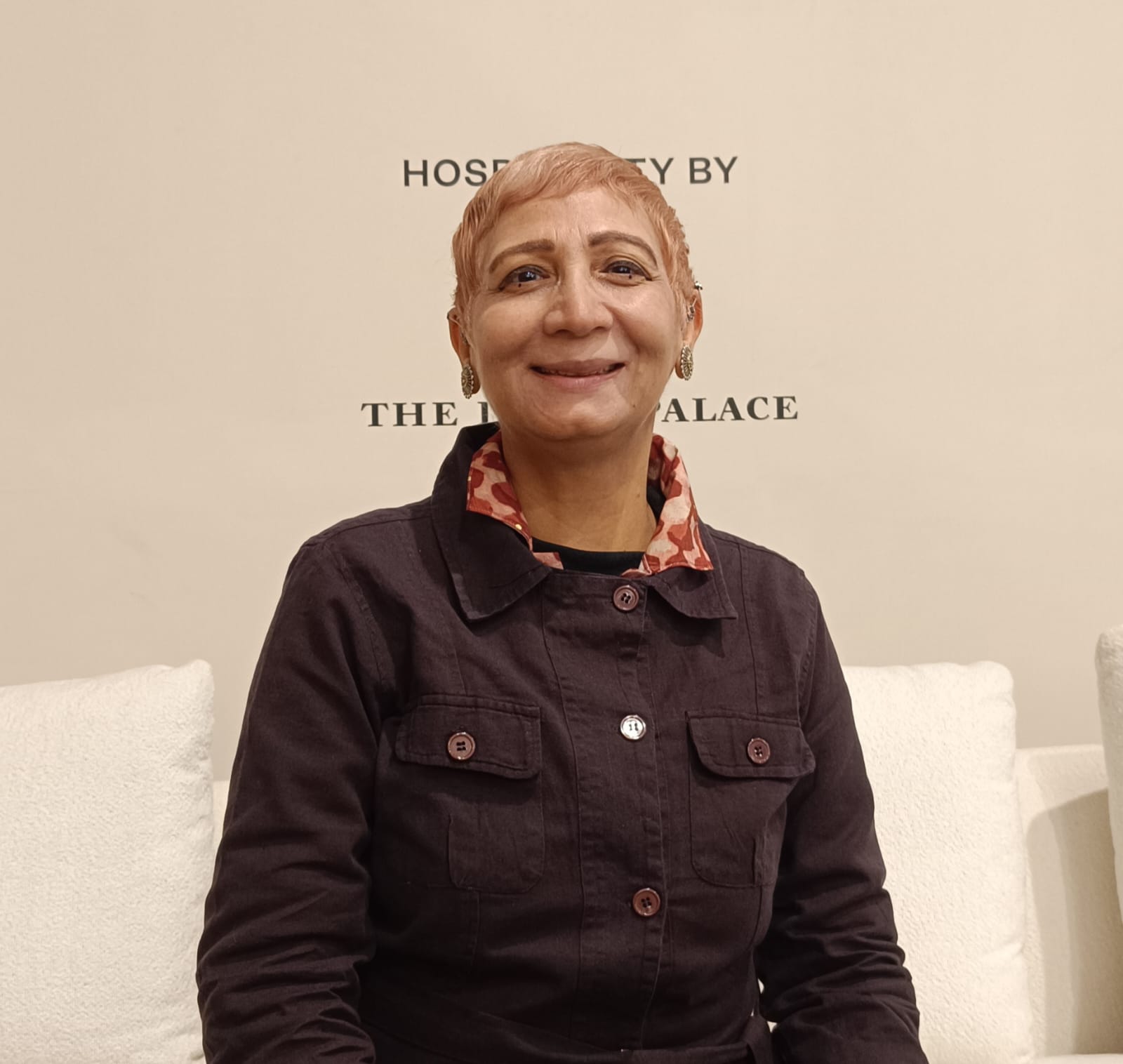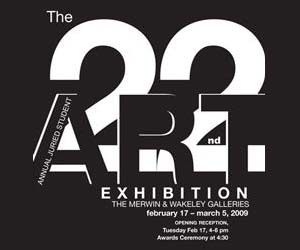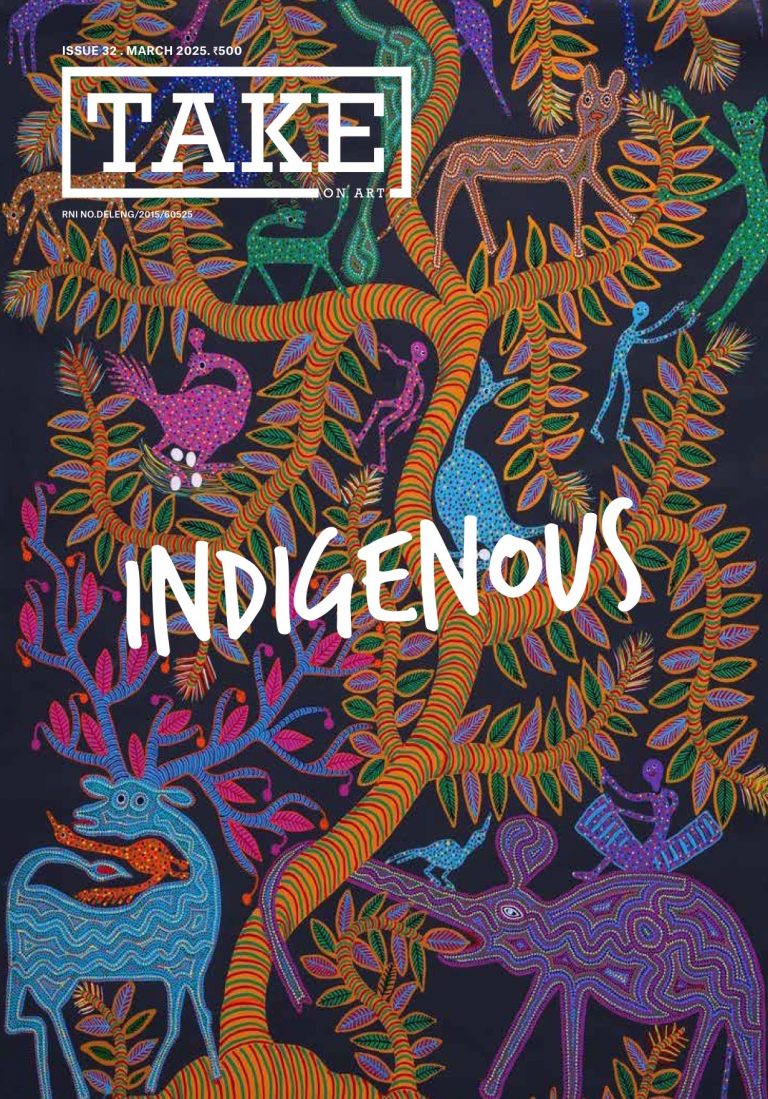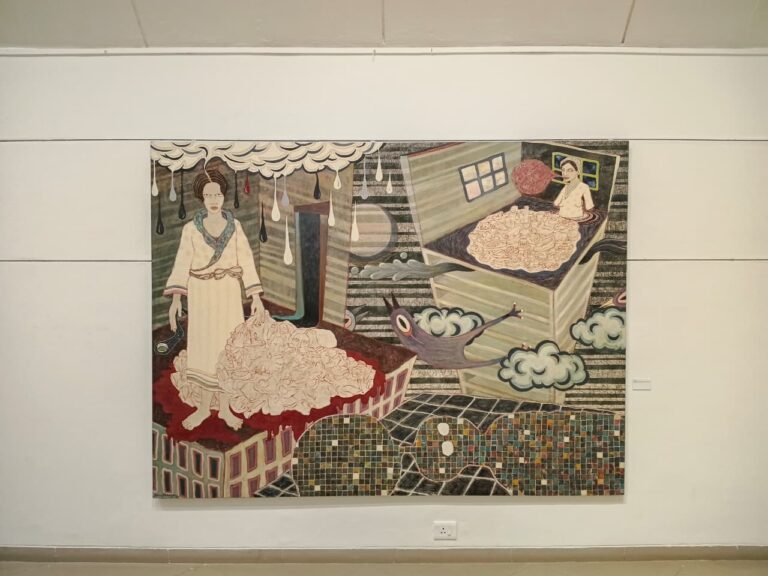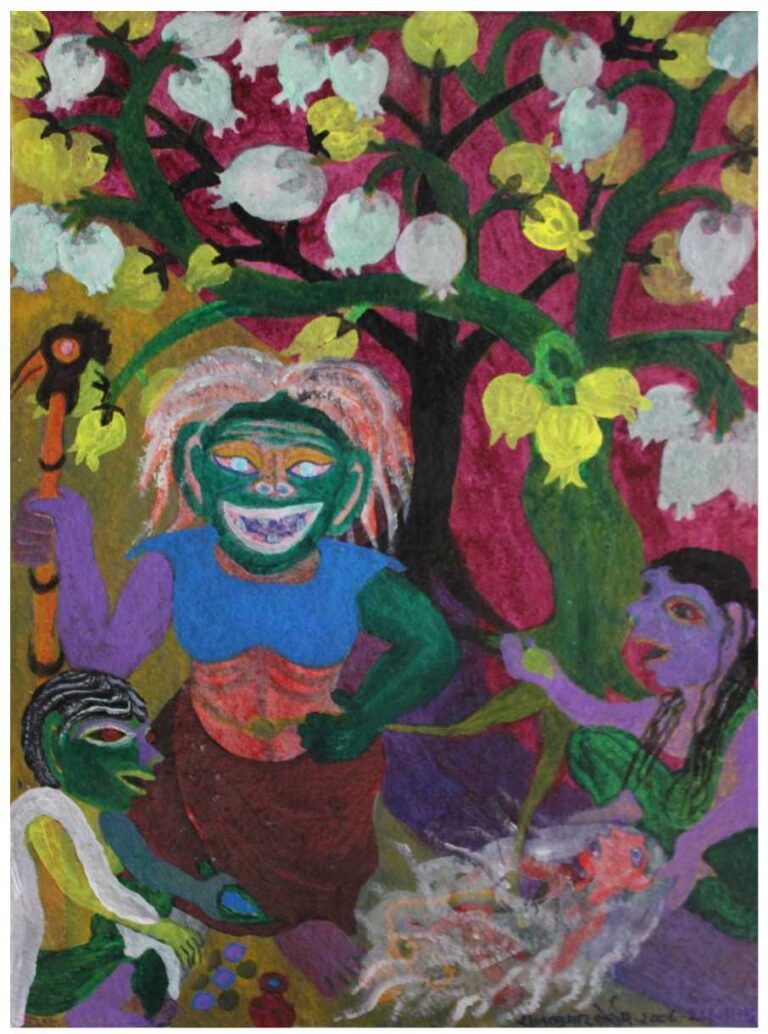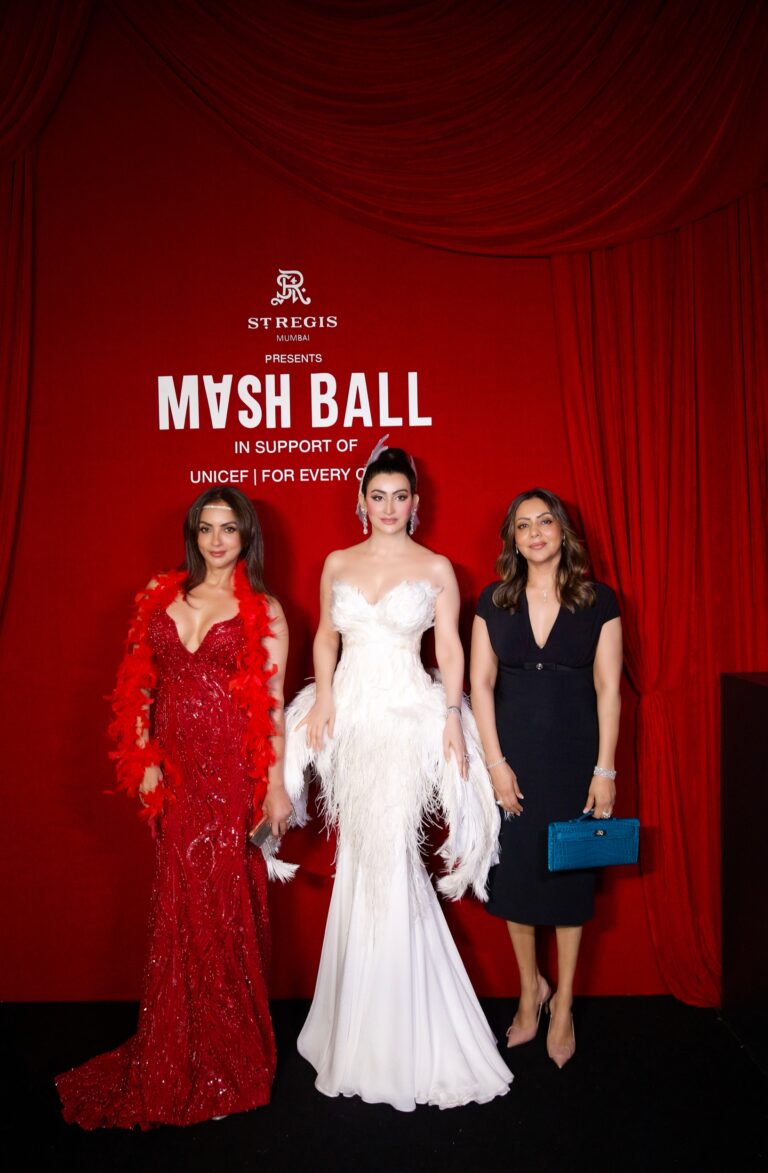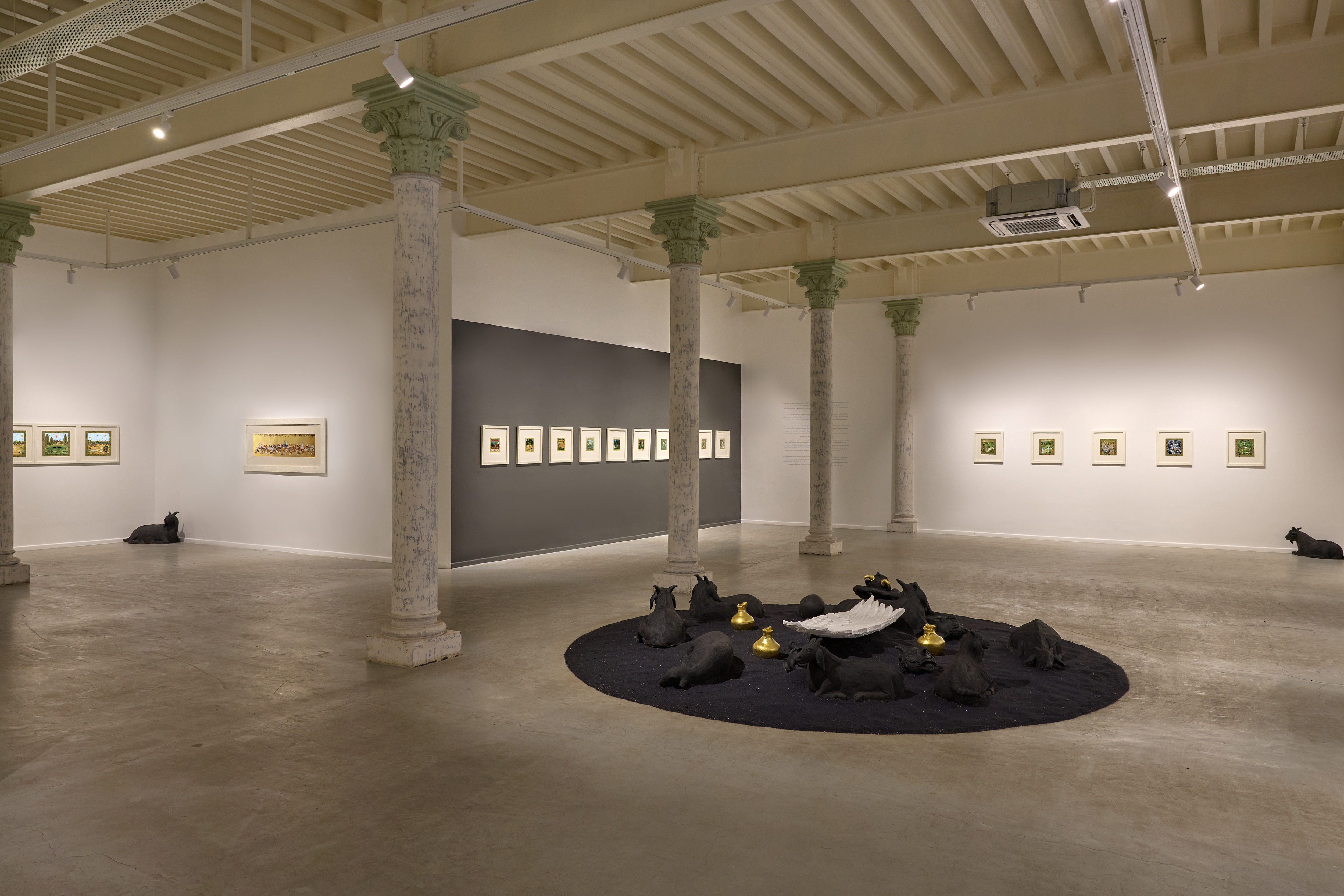
Waswo X. Waswo’s exhibition Heaven (And That Other Place) at Galerie ISA portrayed, in part, Deleuze and Guattari’s Rhizome Philosophy. The posthuman figures in pastoral paintings, unlike the human, do not reduce everything to an object to be dominated; on the contrary, the series rethinks the world in relational terms. Defined by a framework of shared principles, this posthuman world moves away from transactions into friendships, the mycelium, marked by collaboration and harmony. A posthuman experience and future, redolent in The Forest Of Prayers and The Circle Of Life on wasli.
The introductory artwork itself is suggestive of an alternative reality. Titled Another Level, enfolding playful subversion, the trees stand upside down, the Fedora man (evocative of R.K. Laxman’s Common Man), in his quintessential western attire, assumes the stance of a meditative yogi. The birds (reminiscent of the Tutinama) soar high, intersecting with amorphous forms, clouds in Persian miniature, derived from Chinese artistic influences. The Quiet Explorer embarks on a metaphysical quest of confronting his mortality with the expansive beauty of nature. He coalesces Eastern and Western philosophy to comprehend the dichotomy of light and dark in the circle of life. He finds joy in the instinctive lives of animals, the dailiness of simple country folk, interspersed with ponderings on cosmic principles and the make-up of the universe. An evocative expression of Waswo’s disposition may best be found in Jalaluddin Rumi’s poem, ‘The Guest House’. “This being human is a guest house/Every morning a new arrival/A joy, a depression…/ meet them at the door laughing…”
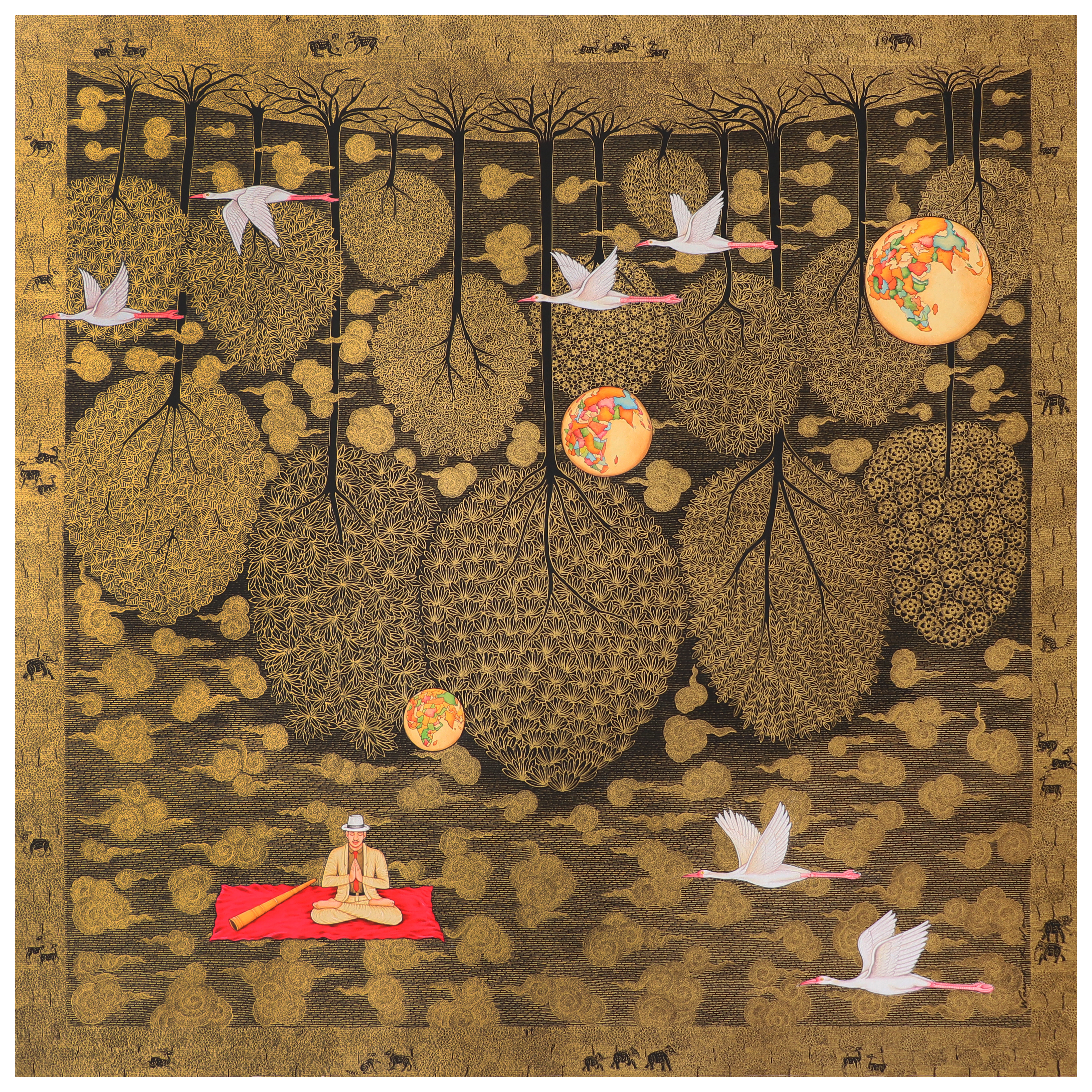
The epicentre in many of the artworks is a black hole, symbolising nothingness, fear and mystery. As much as the daily delights engage the artist, evidenced by the buoyant balloons levitating human figures of the orientalist and his partner Tommy in The Unbearable joy of Life, Waswo’s The Fascination with the enigmatic darkness, that other unknown place, is pervasive even at the cost of his stability and balance.
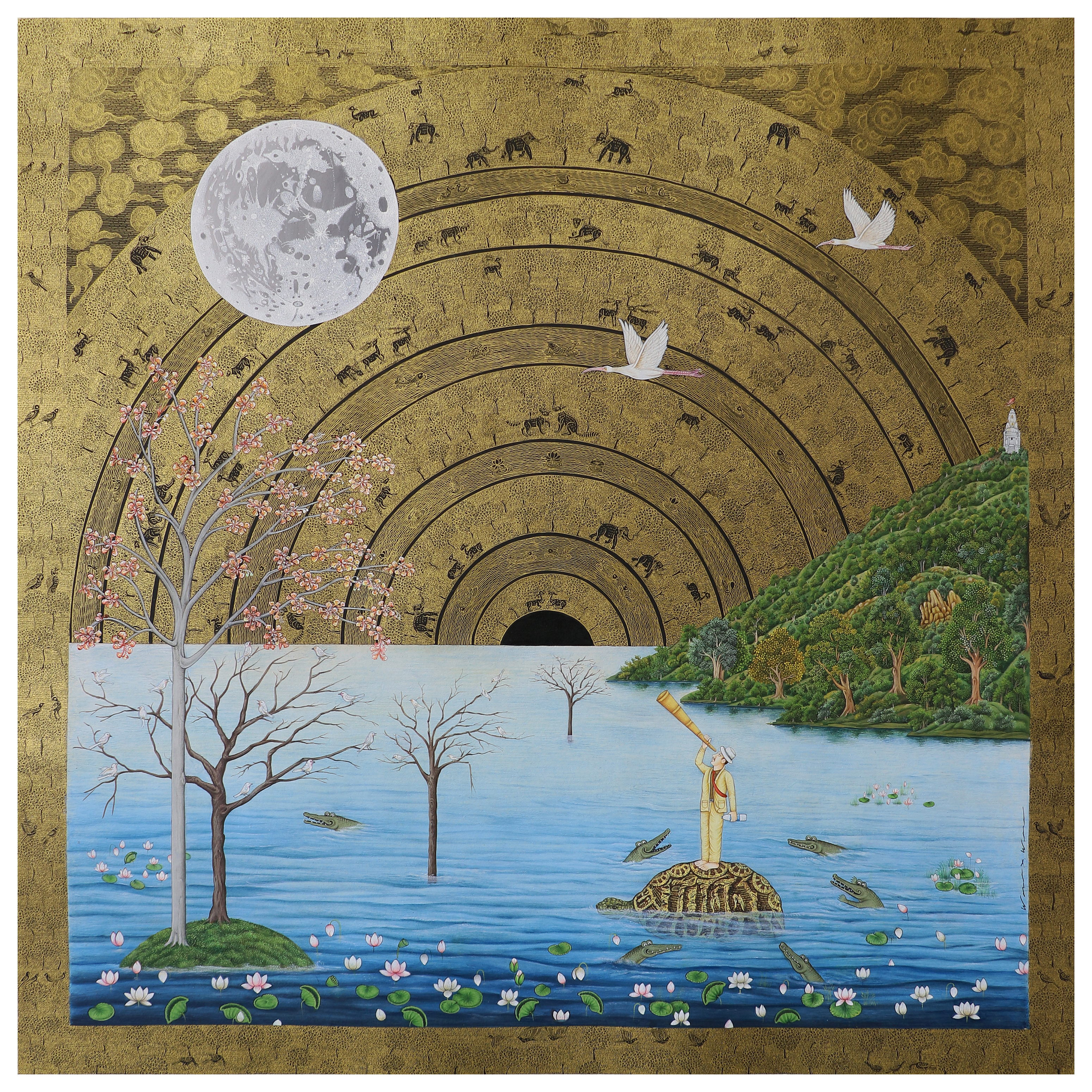
The tour de force of the black and gold paintings are two triptychs, The Three Places: Ascension-Heaven-Descension and Temptation. In Ascension-Descension and Temptation Waswo portrays duality in its fiery polarity. According to Jungian thought, the way to the Self begins with the conflict of opposites, and a real solution comes from within, and only when a person has been brought to a different attitude, ‘coniunctio’. The essence of this arrival is replicated in the painting Heaven and A Day in the Country. Here the artist, devoid of conflict, rejoices in the gift of the present, moments of pure elation and enlightenment, encircled by the beautiful black bucks, a Becoming.
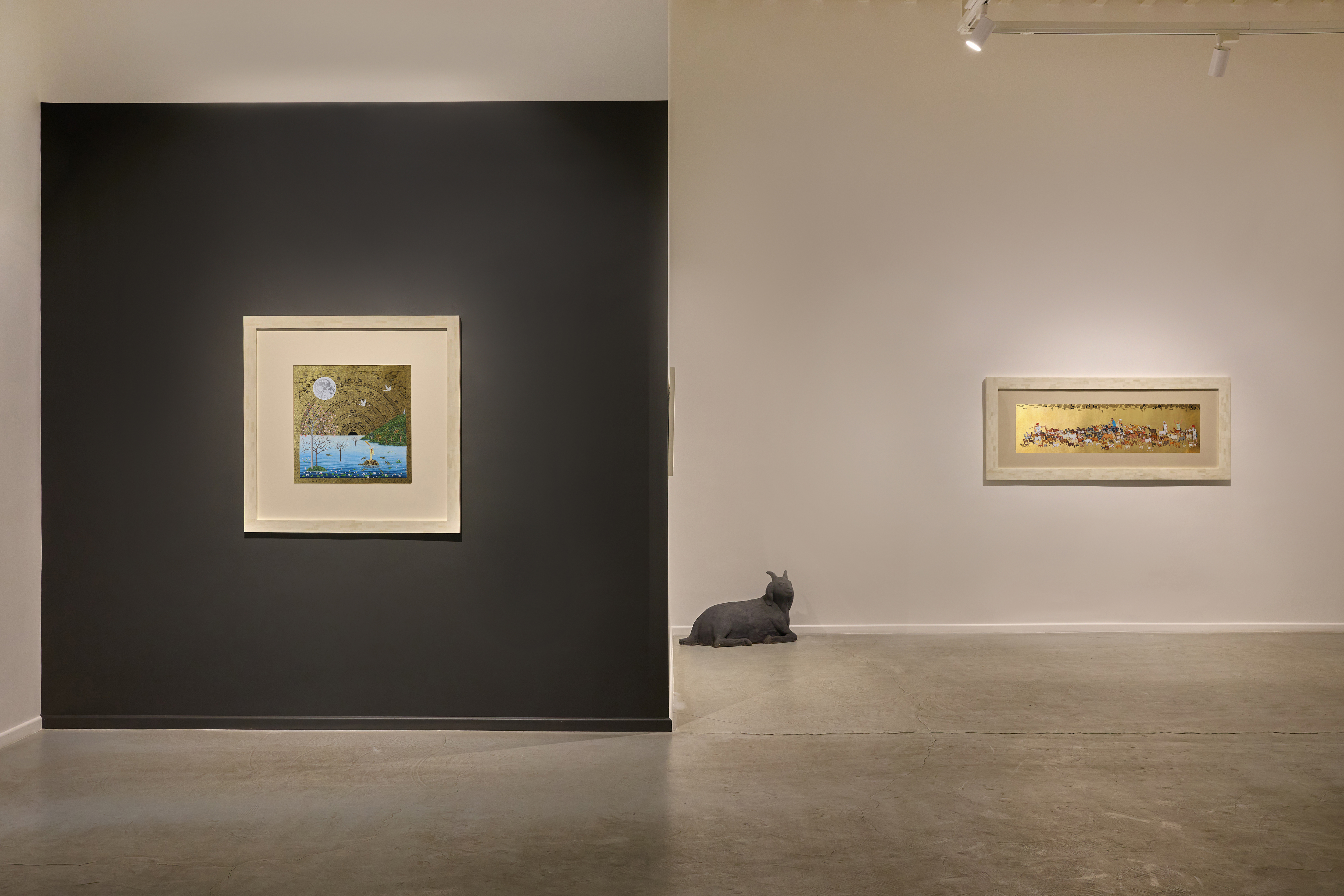
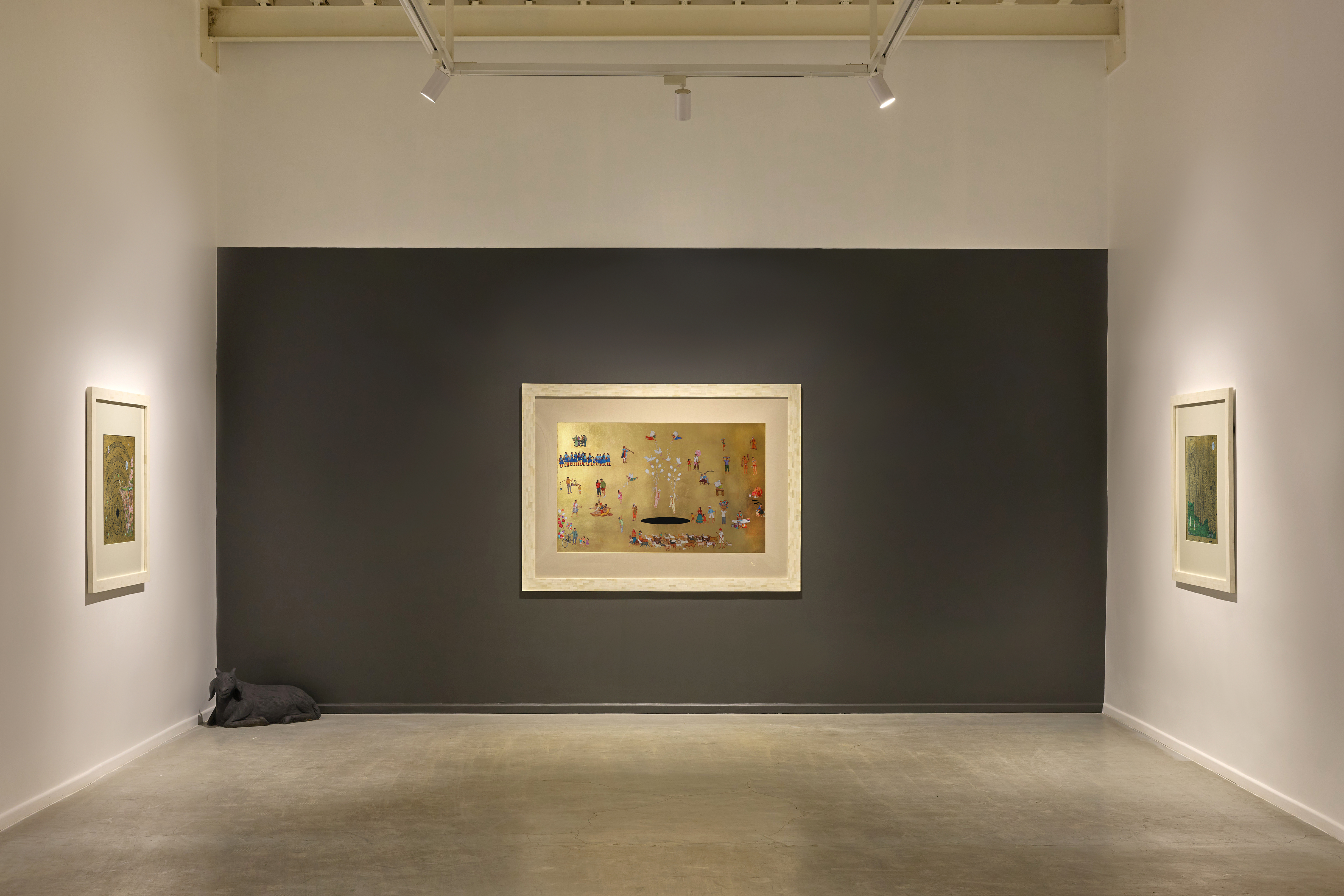
In the paintings You Never Know, The Sense Of Eternity and The Circle Of Life, the artist juxtaposes peril and evil (bats and crocodiles) with stability and celestial symmetry (turtle and the music of the spheres) reminiscent of line from ‘The Tyger’ by William Blake, “Did he who made the Lamb make thee?” The shadow, that other place, confers completeness.
To arrive at wholeness, the artist conceptualises two artworks, It’s Not The Tower That Protects You and We Survive By Helping Hands. Grappling with inner battles in the waters of the dark unconscious, the orientalist may have become traumatised or drowned if the group had not risen to the occasion and saved him from the turbulent waters. “Trauma is not what happens to us, but what we hold inside in the absence of an empathetic witness,” the idea by Peter Levine twined with the saying by Bell Hooks, “Rarely, if ever, are any of us healed in isolation. Healing is an act of communion”, sums up the core of Waswo’s philosophy.
The Sadhu and Owl series are the other subsets in the exhibition. The leitmotifs of the series– the ‘Sadhu’ and the ‘Owl’– are threaded together with their connotations of wisdom and all-seeing-knowledge. The selection of the Owl as a recurring motif yet again folds in the duality of good and evil. There are associations with Goddess Lakshmi and Athena, and being a creature of the night, with the shadowy realms of the subconscious and underworld journeys. The two series are open-ended, whimsical and witty. Whereas the Sadhu sequence speaks of the Guru-Shishya Parampara in Indian tradition, the Owl with its wide-eyed expression invites the viewers to knit their own meaning into the visual presentations.
Tending to pop art, Waswo further weaves in an artistic medley from both East and West through Jeff Koons balloon poodle, Michelangelo’s David along with the wish-fulfilling Kamdhenu Cow, Shrinathji and a tribute to the miniature painter Nainsukh. If the sacred cow denotes purity and non-erotic fertility, the homoerotic panel overshadowed by the penetrating gaze of the archetypal mother (Ravinder Reddy’s golden female bust) bridges the dichotomy of the sacred and profane. A stand-alone piece, sadhu series # 3 is motivated by the miniature painting The Conference of the Birds’ by Habiballah of Sava .
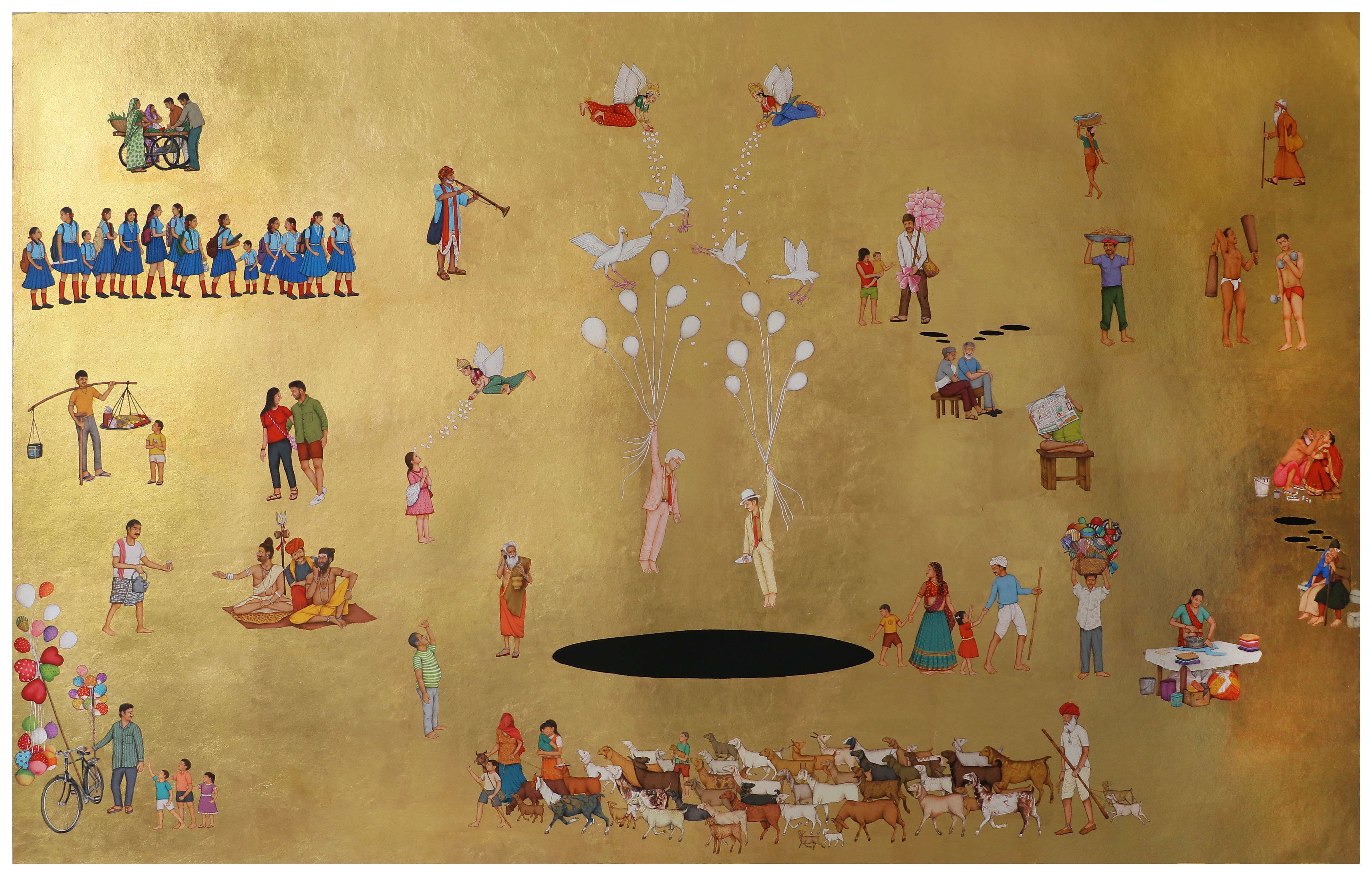
The poetic sensibility of the series is inspired by artists of the Mewar and Mughal school of miniature painting; to name a few, Ghasiram Hardev Sharma and Narottam Narayan Sharma (Nathdwara), Ustad Mansur, Abu’l-Hasan, Basāwan, and the Pahari painter Nainsukh. The stone pigments in the paintings range from real gold, pyavri (yellow), white zinc, Prussian blue, sindhur, surma, raw sienna, burnt sienna, lapis lazuli, malachite, realgar, indigo, hingula, and many more. The gold work in the artworks is exclusively rendered by the miniaturist, Shankar Kumawat. He also excels in his signature well-crafted trees and the golden borders inspired by the decorative margins of Mughal miniature paintings. The figures in the series are the excellent workmanship of Chirag Kumawat. Dalpat Jingar, the master painter of the Sadhu and Owl series, brings his unique style to the artworks, articulating a different language and vocabulary. Banti Jingar’s role is like the Bass player in the orchestra of image and colours. He grinds the pigments, arriving at the right tone and compositions. Ganpat Mali is the fifth in the contingent to assist the artists in the Karkhana.
In keeping with the times, Waswo X. Waswo’s atelier has endeavoured to create a posthuman world, an alternative contemporary to the miniature painting tradition of India, a challenge to society to live the idea and make it a human reality.
Waswo X Waswo, Heaven (And That Other Place), October 10- November 17, 2024, GALERIE ISA, Mumbai.









